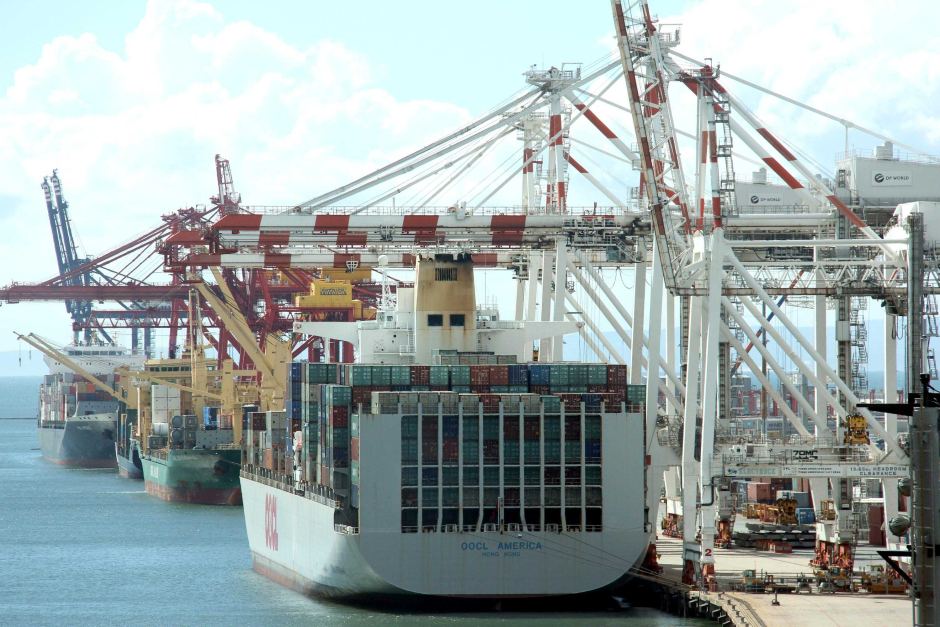Category: Economic Trends / Money and Monetary Policy
Australian economy shrinks 0.5pc in worst fall since GFC
Wednesday, 7 Dec 2016 08:33:28 | Michael Janda

OOCL America docked at the Port of Brisbane. (ABC News: Giulio Saggin, file photo)
Australia's economy shrank 0.5 per cent in the September quarter, well below already pessimistic analyst forecasts and its steepest decline since the global financial crisis of late-2008.
Key points:
- Annual GDP growth 1.8pc, quarterly contraction 0.5pc
- Public capital spending, private building investment and net exports drive fall
- Real net national disposable income rises 0.8pc in quarter on higher export prices
The annual rate of growth came in at an anaemic 1.8 per cent, according to the Bureau of Statistics data, also below expectations.
Economists were generally expecting a slight fall in gross domestic product (GDP), with the typical forecast for a -0.1 per cent quarter and economic growth of 2.2 per cent over the year.
A range of partial figures led analysts to their downbeat predictions, with yesterday's trade data pointing to a 0.2 percentage point subtraction from economic growth, while construction data released last week were much worse than expected and business investment was also weak.
However, the final result was considerably weaker than forecast, pushing the Australian dollar down the best part of half a cent to 74.2 US cents by 11:38am (AEDT).
The final National Accounts data showed that slumping private investment in new dwellings contributed 0.3 percentage points to the GDP decline, with new engineering detracting 0.2 percentage points.
Public capital expenditure, such as infrastructure investment, knocked 0.5 percentage points off growth in the September quarter after a strong June quarter.
The ABS noted that higher-than-usual rainfall contributed to much of the decline in building activity.
Analysts say recession unlikely as national income jumps
The last time Australia had a negative quarter was March 2011, when floods in Queensland knocked out a large part of the nation's coal production.
Prior to that, Australia had negative quarters in December 2008 (where the economy shrank 0.7 per cent during the global financial crisis), and December 2000 (a 0.3 per cent fall following a flat September quarter on the introduction of the GST).
However, one negative quarter does not meet the widely accepted definition of a recession, which requires two falls in a row, and last occurred in Australia in the first half of 1991.
Another positive is that GDP has rebounded by 1.1 per cent in the quarter immediately after each of the previous three negative quarters since the early-'90s recession.
Capital Economics analyst Paul Dales said some kind of rebound is likely again in the current quarter.
"When annual jobs growth has slumped to a two-year low at the same time, there is certainly evidence of a widespread weakening in the economy," he observed.
"But the 0.5 per cent month-on-month rebound in retail sales in October suggests that the fourth quarter got off to a good start and a possible 12 per cent quarter-on-quarter leap in the terms of trade in the fourth quarter will boost incomes too.
"So Australia will probably avoid its first recession (two consecutive quarters of falling output) in 25 years."
Also in better news, the recent trend of "nominal GDP" and income growth lagging so-called "real GDP" because of falling commodity prices amid rising export volumes reversed last quarter, pushing these more accurate measures of household and budget income higher.
Nominal GDP rose 0.5 per cent in the September quarter and 3 per cent over the year and has a much closer relationship with budget revenue than the headline ABS figure.
Real net national disposable income, which the ABS describes as the National Accounts' best measure of household wellbeing, also rose 0.8 per cent in the September quarter largely due to a 4.5 per cent jump in the price of Australia's exports relative to the cost of imports.
Treasurer Scott Morrison said that a 0.5 per cent rise in real net national disposable income per capita was welcome news.
"That is the first time we have seen three consecutive quarters of growth in this living standards measure since 2011," he told reporters.
- About Us
- |
- Terms of Use
- |
-
 RSS
RSS - |
- Privacy Policy
- |
- Contact Us
- |
- Shanghai Call Center: 962288
- |
- Tip-off hotline: 52920043
- 沪ICP证:沪ICP备05050403号-1
- |
- 互联网新闻信息服务许可证:31120180004
- |
- 网络视听许可证:0909346
- |
- 广播电视节目制作许可证:沪字第354号
- |
- 增值电信业务经营许可证:沪B2-20120012
Copyright © 1999- Shanghai Daily. All rights reserved.Preferably viewed with Internet Explorer 8 or newer browsers.




 Send to Kindle
Send to Kindle